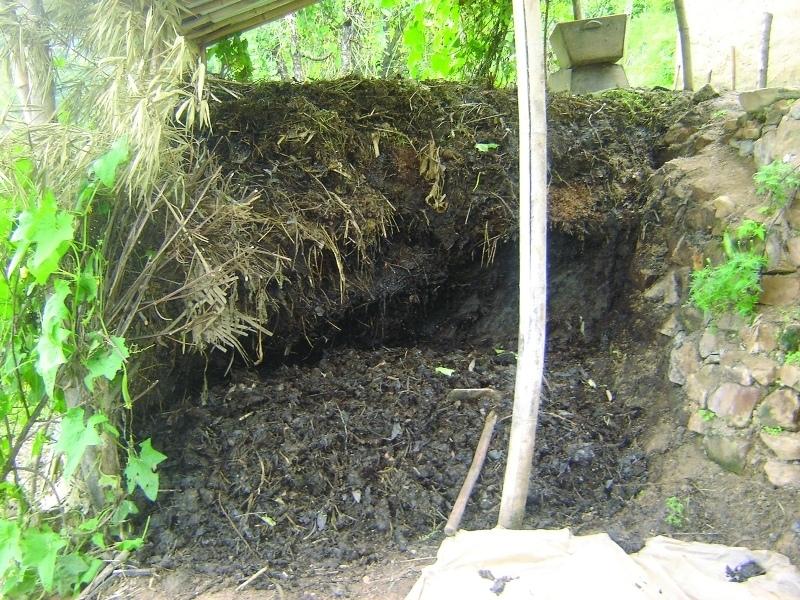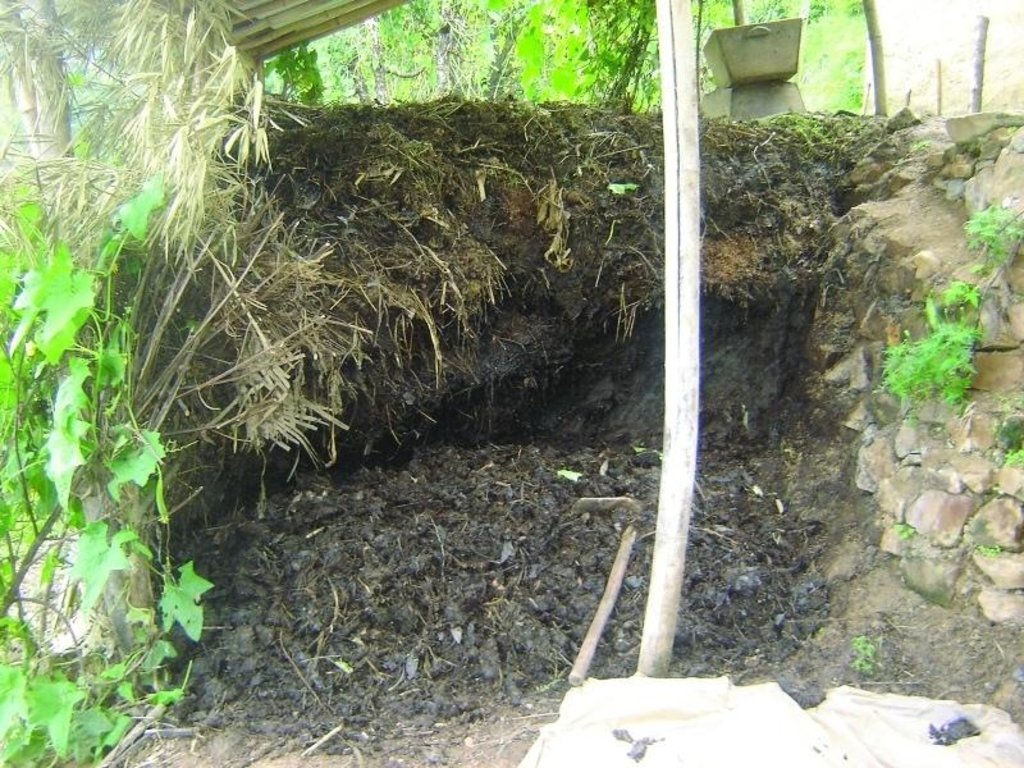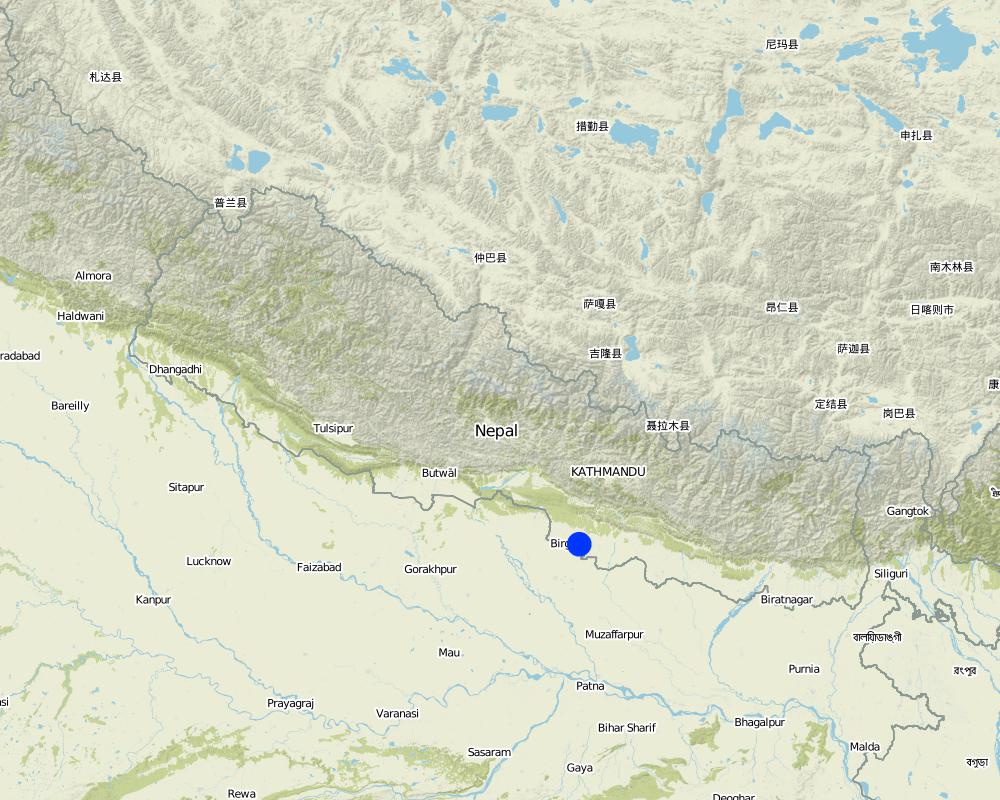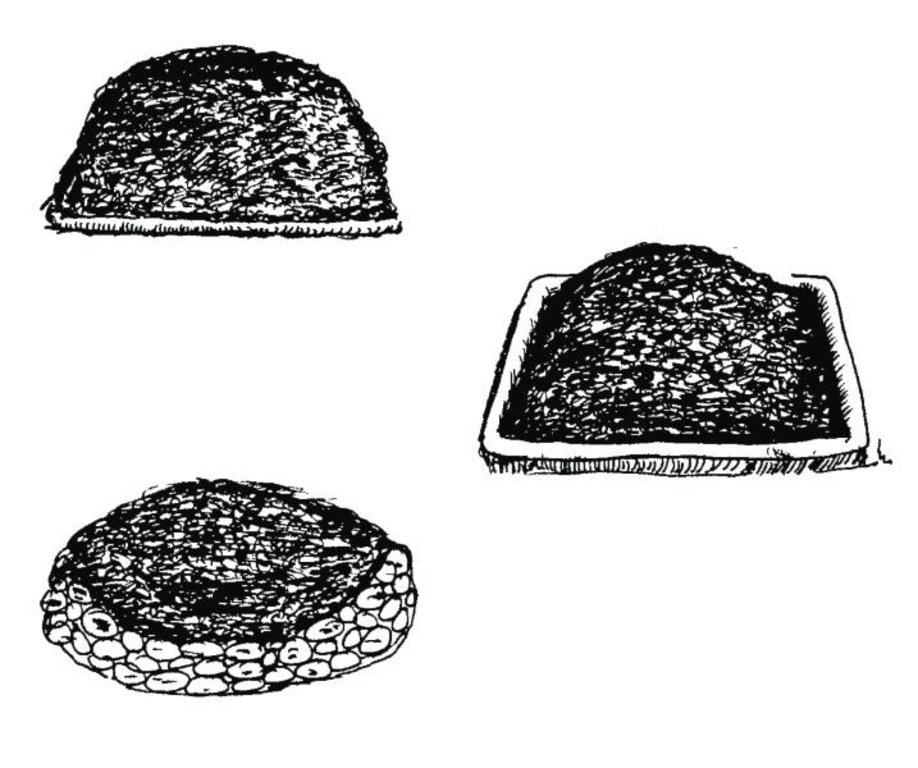Better quality farmyard manure through improved decomposition [尼泊尔]
- 创建:
- 更新:
- 编制者: Richard Allen
- 编辑者: –
- 审查者: David Streiff, Alexandra Gavilano
Upayukta bighatan prakriya dwara ramro gunastar ko gothemal (Nepali)
technologies_1759 - 尼泊尔
查看章节
全部展开 全部收起1. 一般信息
1.2 参与该技术评估和文件编制的资源人员和机构的联系方式
SLM专业人员:
Director
Soil Management Directorate, Department of Agriculture
尼泊尔
SLM专业人员:
Team Leader
Sustainable Soil Management Programme
尼泊尔
有助于对技术进行记录/评估的项目名称(如相关)
Sustainable Soil Management Programme, Nepal (SSMP)有助于对技术进行记录/评估的机构名称(如相关)
Department of Agriculture, Soil Management Directorate, Hariharbhawan Lalitpur (doasoil) - 尼泊尔有助于对技术进行记录/评估的机构名称(如相关)
HELVETAS (Swiss Intercooperation)1.3 关于使用通过WOCAT记录的数据的条件
编制者和关键资源人员接受有关使用通过WOCAT记录数据的条件。:
是
1.5 参考关于SLM方法(使用WOCAT记录的SLM方法)的调查问卷

Farmer field schools on integrated plant nutrient systems [尼泊尔]
Participatory and collaborative learning through the farmer field school approach
- 编制者: Richard Allen

Farmer-to-farmer diffusion [尼泊尔]
Wider diffusion of sustainable soil management technologies through a demand responsive farmer-to-farmer diffusion approach
- 编制者: Richard Allen
2. SLM技术的说明
2.1 技术简介
技术定义:
Collection and proper storage of farmyard manure in heaps or pits
2.2 技术的详细说明
说明:
Farmyard manure - a varying mixture of animal manure, urine, bedding material, fodder residues, and other components - is the most common form of organic manure applied in the midhills of Nepal. Farmyard manure has a high proportion of organic material which nurtures soil organisms and is essential in maintaining an active soil life. Only about half of the nutrient content of farmyard manure becomes available for crop growth during the first year after it has been applied to the soil - the rest is channeled through soil biotic processes and the nutrients are released in the following years. The high organic matter content and the active soil life improve or maintain friable soil structures, increase the cation exchange capacity, water holding capacity, and infiltration rate, and reducing the risk of soil pests building up.
Indigenous methods of preparing and using farmyard manure vary widely depending on the ecological zone, access to bedding material from crop or forest land, access to crop residues and fodder, labour availability, and other factors. A prerequisite for the manure having a positive impact on soil fertility is that it is properly decomposed. The application of partially decomposed manure can increase the number of white grubs, red ants and other soil pests.
Decomposition is enhanced and the time it takes to happen is reduced if the manure is kept warm and moist (but not wet) at all times. Heaping the manure up or storing it in a pit helps. Whether it is best to heap up the manure or put it in a pit depends on the local climate. Heaping has the advantage of being less costly, while the pit method reduces runoff and the loss of nutrient rich fluids. Adding nitrogen in the form of urine (N) improves the carbon to nitrogen ratio.
2.3 技术照片
2.5 已应用该技术的、本评估所涵盖的国家/地区/地点
国家:
尼泊尔
有关地点的进一步说明:
Midhills districts of Nepal
具体说明该技术的分布:
- 适用于特定场所/集中在较小区域
Map
×3. SLM技术的分类
3.1 该技术的主要目的
- Access to manure
3.2 应用该技术的当前土地利用类型

农田
- 一年一作
注释:
Major land use problems (compiler’s opinion): Intensifying cultivation practices with either 1) inadequate application of fertilisers leading to a decline in soil fertility and the mining of soil nutrients or 2) application of too much fertiliser causing environmental problems through excessive leaching, and losses of fertiliser in surface runoff and consequent eutrophication or nitrification of streams, ponds or groundwater.
3.5 该技术所属的SLM组
- 土壤肥力综合管理
3.6 包含该技术的可持续土地管理措施

管理措施
- M2:改变管理/强度级别
3.7 该技术强调的主要土地退化类型

化学性土壤退化
- Cn:肥力下降和有机质含量下降(非侵蚀所致)
3.8 防止、减少或恢复土地退化
具体数量名该技术与土地退化有关的目标:
- 减少土地退化
4. 技术规范、实施活动、投入和成本
4.1 该技术的技术图纸
技术规范(与技术图纸相关):
a) Heap method
b) Pit method
c) Semi-pit method
The method should be chosen that
is most convenient and provides the
most favourable environment for
decomposition of the manure.
Generally heaps and pits are about 1 to 2m in diameter
depending on the amount of
manure produced and required.
Technical knowledge required for field staff / advisors: low
Technical knowledge required for land users: low
Main technical functions: increase in organic matter, increase in soil fertility, increase in soil productivity
Secondary technical functions: increased infiltration rate and water holding capacity, improved soil physical properties
Layout change according to natural and human environment: heaping or storage in pits
4.2 有关投入和成本计算的一般信息
具体说明成本计算所用货币:
- 美元
注明雇用劳工的每日平均工资成本:
2.00
4.3 技术建立活动
| 活动 | 时间(季度) | |
|---|---|---|
| 1. | Dig a 1m deep and 2m diameter pit using a shovel or spade. | |
| 2. | Pit method: Put dung mixed with leaf litter, bedding material and fodder residues in the pit until it is full. | |
| 3. | Apply urine directly over the manure heap using a plastic pipe or jug. | |
| 4. | Cover the heap with a fine layer of straw, mud, soil or plastic sheet or any other suitable local materials to protect it from direct sunlight and excessive water. |
4.4 技术建立所需要的费用和投入
| 对投入进行具体说明 | 单位 | 数量 | 单位成本 | 每项投入的总成本 | 土地使用者承担的成本% | |
|---|---|---|---|---|---|---|
| 劳动力 | Preapring manure pit | Persons/day | 1.0 | 2.0 | 2.0 | 100.0 |
| 技术建立所需总成本 | 2.0 | |||||
| 技术建立总成本,美元 | 2.0 | |||||
4.5 维护/经常性活动
| 活动 | 时间/频率 | |
|---|---|---|
| 1. | About one month after beginning to collect and pile up the material, turn | |
| 2. | Depending on the location, it takes about 3-4 months to prepare fully decomposed farmyard manure. |
4.6 维护/经常性活动所需要的费用和投入(每年)
| 对投入进行具体说明 | 单位 | 数量 | 单位成本 | 每项投入的总成本 | 土地使用者承担的成本% | |
|---|---|---|---|---|---|---|
| 劳动力 | Decompose manure | Persons/day | 1.0 | 2.0 | 2.0 | 100.0 |
| 技术维护所需总成本 | 2.0 | |||||
| 技术维护总成本,美元 | 2.0 | |||||
注释:
Cost as in January 2007
4.7 影响成本的最重要因素
描述影响成本的最决定性因素:
The heap method is cheaper, as no digging is involved
5. 自然和人文环境
5.1 气候
年降雨量
- < 250毫米
- 251-500毫米
- 501-750毫米
- 751-1,000毫米
- 1,001-1,500毫米
- 1,501-2,000毫米
- 2,001-3,000毫米
- 3,001-4,000毫米
- > 4,000毫米
有关降雨的规范/注释:
Annual rainfall: Also 2000-3000 mm
农业气候带
- 潮湿的
Thermal climate class: subtropics
5.2 地形
平均坡度:
- 水平(0-2%)
- 缓降(3-5%)
- 平缓(6-10%)
- 滚坡(11-15%)
- 崎岖(16-30%)
- 陡峭(31-60%)
- 非常陡峭(>60%)
地形:
- 高原/平原
- 山脊
- 山坡
- 山地斜坡
- 麓坡
- 谷底
垂直分布带:
- 0-100 m a.s.l.
- 101-500 m a.s.l.
- 501-1,000 m a.s.l.
- 1,001-1,500 m a.s.l.
- 1,501-2,000 m a.s.l.
- 2,001-2,500 m a.s.l.
- 2,501-3,000 m a.s.l.
- 3,001-4,000 m a.s.l.
- > 4,000 m a.s.l.
关于地形的注释和进一步规范:
Slopes on average: Also moderate (6-10%), rolling (11-15%) and hilly (16-30%)
Landforms: Also footslopes
Altitudinal zone: Also 1000-1500 m a.s.l., 1500-2000 m a.s.l. and 2000-2500 m a.s.l.
5.6 应用该技术的土地使用者的特征
生产系统的市场定位:
- 生计(自给)
- 混合(生计/商业)
个人或集体:
- 个人/家庭
说明土地使用者的其他有关特征:
Off-farm income specification: In most farm households, off-farm income plays at least a minor and increasingly a major role. Occasional opportunities for off-farm income present themselves in the form of daily labour wages. Some households’ members receive regular salaries, whilst an increasing number of Nepalis are working in India, the Middle East, Malaysia, and elsewhere and sending remittance incomes home.
Market orientation of production system: Also commercial/ market
5.7 应用该技术的土地使用者使用的平均土地面积
- < 0.5 公顷
- 0.5-1 公顷
- 1-2 公顷
- 2-5公顷
- 5-15公顷
- 15-50公顷
- 50-100公顷
- 100-500公顷
- 500-1,000公顷
- 1,000-10,000公顷
- > 10,000公顷
5.8 土地所有权、土地使用权和水使用权
土地所有权:
- 个人,未命名
- 个人,有命名
土地使用权:
- 租赁
- 个人
注释:
sharecropping between owner and tenant
6. 影响和结论性说明
6.1 该技术的现场影响
社会经济效应
生产
作物生产
收入和成本
农业投入费用
注释/具体说明:
Reduced cash expenses on agrochemicals (fertilisers, pesticides; substituted by labour)
其它社会经济效应
Cleaner environment around houses if manure heap or pit is well maintained
生态影响
其它生态影响
Incidence ofsoil pests (white grub, red ant)
Application of mineral fertilisers
6.2 该技术的场外影响已经显现
地下水/河流污染
注释/具体说明:
Reduced influx of nutrients into water bodies
Dependence on outside inputs
6.4 成本效益分析
技术收益与技术建立成本相比如何(从土地使用者的角度看)?
短期回报:
积极
长期回报:
积极
技术收益与技术维护成本/经常性成本相比如何(从土地使用者的角度看)?
短期回报:
积极
长期回报:
积极
注释:
The high costs of mineral fertiliser mean that the establishment costs are recovered quarterly. Over the long-term, the major reduction in costs leads to large benefits.
6.5 技术采用
注释:
Comments on acceptance with external material support: Heap and pit methods have been very well accepted and adopted widely ( 60-70% ) of among participants in SSMP.The semi-pit method is not as accepted as the other methods due to its high initial establishment costs.
6.7 该技术的优点/长处/机会
| 编制者或其他关键资源人员认为的长处/优势/机会 |
|---|
|
The use of improved and well-decomposed farmyard manure reduced the need for mineral fertiliser and pesticides thereby reducing production costs, cash expenditure, and outside dependency How can they be sustained / enhanced? Further promote the technology to increase this impact. |
| The use of fully decomposed farmyard manure reduces pest incidence, especially attacks of red ants and white grubs |
6.8 技术的弱点/缺点/风险及其克服方法
| 编制者或其他关键资源人员认为的弱点/缺点/风险 | 如何克服它们? |
|---|---|
| The initial establishment costs for building a semi-pit may hamper adoption |
Promote alternative methods of building a semi-pit without using cement and using local resources |
7. 参考和链接
7.1 信息的方法/来源
7.2 参考可用出版物
标题、作者、年份、ISBN:
STSS; SSMP (2001) Farmyard Manure and Compost Management (in Nepali) Kathmandu: Soil Testing Services Section, Department of Agriculture and Sustainable Soil Management Programme
可以从哪里获得?成本如何?
SSMP
链接和模块
全部展开 全部收起链接

Farmer field schools on integrated plant nutrient systems [尼泊尔]
Participatory and collaborative learning through the farmer field school approach
- 编制者: Richard Allen

Farmer-to-farmer diffusion [尼泊尔]
Wider diffusion of sustainable soil management technologies through a demand responsive farmer-to-farmer diffusion approach
- 编制者: Richard Allen
模块
无模块





